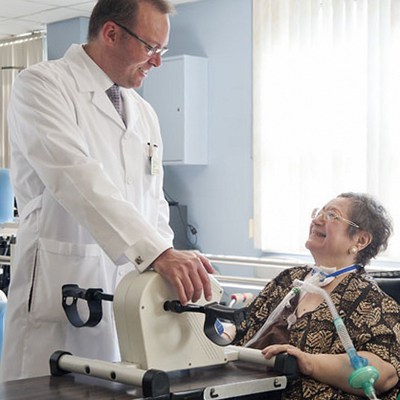Evidence Based Support for Using a PMV ® In-line with Mechanical Ventilations
Anna-Liisa Sutt, BA, MA Speech Pathology
Kristin King, PhD, CCC-SLP, Vice President of Clinical Education and Research, Passy-Muir, Inc.
Introduction

Misconceptions exist about potential risks for harming a patient’s already-compromised lungs during recovery if a speaking valve is used with patients who are mechanically ventilated, and these misconceptions tend to hinder use of speaking valves with this population. Arguments about use of a one way speaking valve during mechanical ventilation include the ideas that there are increased risks of aspiration due to cuff deflation, decreased lung recruitment because of lost ventilation with cuff deflation, and even increased risk of barotrauma because of increased lung pressures. While the purpose of mechanical ventilation is to support the respiratory system during recovery, the changes it causes in the physiologic function of the respiratory system also lead to deleterious effects on secretion management, lung function, communication, swallowing, subglottic pressure, and other parameters affecting function. Frequently, the potential risks are used as reasons to delay use of a speaking valve in-line on the ventilator; however, research does not support them. These a priori assumptions are not substantiated with research, and clinical observations have been providing anecdotal evidence that was contrary to prior teachings. Previously, there has been a paucity of research to support what has been seen clinically; however, current empirical research is demonstrating that the use of a speaking valve in-line with mechanical ventilation is promoting improved ventilation (Sutt et al., 2016) and faster weaning (Carmona et al., 2015), among other benefits.
Additionally, patient centered care focuses on patients’ rights to communicate and participate in their medical care, and patients who are mechanically ventilated have compromised communication which can be emotionally taxing and may lead to miscommunication and even medical errors (Egbers et al., 2014). Because a tracheostomy tube is placed below the level of the vocal folds and mechanical ventilation typically requires the cuff be inflated, air flow does not travel upwards through the vocal folds into the upper airway. During ventilation, airflow is directed between the ventilator and the lungs for both inspiration and expiration. This artificial form of respiration causes many changes to the normal physiologic function of the respiratory and aerodigestive systems. Using a bias closed, one way speaking valve in-line allows airflow to be re-established through the upper airway, providing stimulation to the vocal folds and upper sensory inputs, and patients are able to phonate, verbalize, and have more normalized processes. The positive effects of restored communication for the patient who requires mechanical ventilation have been well documented. In 2016, Freeman-Sanderson et al. reported time to phonation using speaking valves in ICU patients was 11 days sooner than the control group without speaking valves, and subjects reported significant improvements in self-esteem, being understood by others, cheerfulness and quality of life.
So, for patients with mechanical ventilation we have a two-fold process to consider, the changes to the physiologic mechanics of the process of respiration, speech, and swallowing, and the patient’s psychological well-being – all of which affect recovery and outcomes.
Effects on Communication
Recent research is demonstrating that in-line use of the Passy Muir® one way speaking valve (PMV®) during mechanical ventilation is facilitating both communication and improved lung function. Sutt, Cornwell, Mullany, Kinneally, and Fraser (2015) investigated the effect of in-line speaking valves on both the duration of mechanical ventilation and time to verbal communication by collecting data on 129 patients with a mean age of 59 ± 16 years in a retrospective pre- and post-observational study, for years 2011 and 2012, using an ICU informational system and medical records. The purpose of the study was to compare tracheostomy outcomes in patients who were mechanically ventilated by investigating pre-introduction and post-introduction of in-line speaking valves. A significant difference was found for communication, with a 9 day faster implementation of verbal communication post-introduction of the speaking valve. While no difference was found for time of mechanical ventilation or time to decannulation, the authors report that no adverse events were documented in relation to the use of speaking valves in-line with this population. This study not only provides evidence that use of a speaking valve in-line provides patients with earlier access to communication, it reports that use of a speaking valve in-line did not cause any adverse effects.
A follow-up study by Sutt and Fraser (2015) analyzed data for years 2013 – 2014 to evaluate the practice of speaking valve use across ICUs, if it had continued to increase, and the impact on the standard of care. This additional analysis brought the total studied patient population across 4 years to 274 tracheostomized patients in ICU. Comparing the 2013-2014 data points to the earlier 2011-2012 data points, the authors found a significant reduction in the average number of days from tracheostomy tube insertion to return to verbal communication since the previous study. The return to verbal communication since the introduction of a one way speaking valve as a standard of care was now an average of 6 days post tracheostomy. The patient population using speaking valves had significantly increased with the implementation of a protocol for use of speaking valve in-line, from 0% in 2011 to 70% in 2014. The authors report that overall, 75% of their patients with tracheostomy who are mechanically ventilated are now communicating verbally. They also report that the use of the speaking valve and the ability to speak has not been associated with any deterioration of any measurable ventilatory or respiratory outcomes in these patients.
Effects on Lung Function
While these studies primarily reported findings related to communication, Sutt, Caruana, Dunster, Cornwell, Anstey, and Fraser (2016) also investigated the specific effects of in-line use of a one way speaking valve on lung function with patients who are mechanically ventilated. The purpose of this study was to assess end expiratory lung impedance (EELI) and standard bedside respiratory parameters before, during, and after speaking valve use in patients with tracheostomy who were weaning from the ventilator. This prospective observational study was conducted on 20 consecutive patients and used Electrical Impedance Tomography (EIT) to monitor EELI. EIT is a non-invasive, radiation free, imaging tool that measures end expiratory lung volumes. The authors report that use of the speaking valve in-line significantly increased EELI while the valve was in place, and the effect was maintained for at least 15 minutes after removal of the valve. The authors were able to measure and demonstrate that the lungs were more involved in respiration with the speaking valve in-line than without a speaking valve. The authors’ findings demonstrated that speaking valve use did not cause derecruitment of the lungs during ventilator weaning; subsequently, the authors suggest these findings indicate that use of a one-way speaking valve may actually facilitate lung recruitment during and after speaking valve use. The authors also found that respiratory rate and EtCO2 decreased significantly during PMV use with oxygen saturations and heart rate unchanged.
Effects on Respiratory Mechanics
Sutt, Cornwell, Caruana, Dunster, and Fraser (2015) also investigated the use of an in-line speaking valve on respiratory mechanics. This research was initiated secondary to the questions that have arisen related to concerns with derecruitment and atelectasis that may develop with prolonged weaning from mechanical ventilation. The authors studied 18 consecutive patients with tracheostomy who were weaning off ventilation and able to tolerate a speaking valve for 30 minutes. The investigators used EIT and respiratory inductance plethysmography (RIP), which measures abdominal-chest movements ratio, for a total of one hour. The authors also collected oxygenation, end tidal carbon dioxide, respiratory rate, heart rate, and airway pressures. The findings indicated universal improvement in lung recruitment with the speaking valve pre- and post-use as compared to baseline measurements. Significant improvement in abdominal mobility was measured with RIP when the speaking valve was in use. The authors suggest this finding represents an increase in diaphragm involvement in breathing when the speaking valve is in-line. The authors also reported a significant improvement in health related communication for both patients and nursing staff. The authors interpreted these findings to mean that speaking valves are a safe option for enabling verbal communication when patients are on mechanical ventilation. They also reported that improved lung recruitment and diaphragm involvement may improve overall respiratory mechanics and lead to more rapid liberation.
Summary
These recent studies are demonstrating that use of a one way speaking valve in-line with patients who are mechanically ventilated not only provide psycho-social benefits by increasing communication and affecting self-esteem in a positive manner, they also are investigating the physiologic effects on the respiratory system. Current research findings support the previous anecdotal evidence that patients on mechanical ventilation benefit from having access to verbal communication and that using a speaking valve in-line does not cause detrimental effects on lung recruitment or other physical parameters, such as heart rate or oxygen saturations. Sutt et al. (2015, 2016) have begun a series of research studies that demonstrate improved lung function and increased diaphragmatic involvement in respiration without deleterious effects. Freeman-Sanderson et al. (2015, 2016) have investigated the impact on communication and well-being with the additional findings for improved quality of life of ICU patients. In the past the paucity of research for in-line use of valves contributed to the difficulty in having evidence-based practice for use of a Passy Muir® one way speaking valve in-line. However, the current research studies provide strong supporting evidence for both the physiologic improvements and the patient’s well-being.
Researcher’s Perspective
In considering the current trends in research for investigating the use of Passy Muir® Valves in-line with patients who are mechanically ventilated, Anna-Liisa Sutt (first author on many of the cited studies) provides her insight as a researcher into these trends:
1 As a researcher who focuses much of her research on a population of patients who are mechanically ventilated and who, historically, received a hands- off approach with use of speaking valves, what caused you to pursue this line of research?
Starting work in a cardiothoracic ICU where all of my tracheostomised patients were mechanically ventilated, it was devastating to see that all of them were left voiceless. Some of them fully alert, eating and drinking with their tracheostomy cuffs inflated, but left in silence. It was obvious that something needed to be done about it. With Critical Care Research Group (CCRG) on site with all the necessary equipment and expertise, I was in a very lucky situation where setting up a research project was relatively easy with all the help I needed right here at the hospital.
2 Frequently, the use of speaking valves in-line on the ventilator are not pursued for patients who are mechanically ventilated. What do you believe is the biggest misconception about using the valve in-line?
Based on my personal experience in an Australian critical care setting, I believe it is the opinion that the air-leak created by cuff deflation needed for PMV® use may cause derecruitment of the patients’ lungs. The studies in the area of mechanical ventilation put a lot of focus on recruitment manoeuvres and weaning strategies, so anything that could potentially act in the opposite direction, is of course frowned upon. Lack of physiologic data has not been able to support us thus far, either.
Another misconception (though less frequent in my experience) is the fear of aspiration with a deflated cuff.
3 In your research addressing lung recruitment, you have found that with the valve in-line while mechanically ventilated, as measured with EIT, that patients demonstrate increased lung volumes. What are the implications for weaning and recovery?
EIT data showed us that there was increased end-expiratory lung impedance (EELI) during and post PMV use. EELI has been highly correlated with end-expiratory lung volumes (EELV) in other studies, which is why we are referring to it as increased EELV during and after PMV use. End of expiration is when the lungs are at most risk for collapsing. If we are seeing increased EELV, then we can presume that the lungs are kept open better, and are therefore less likely to collapse/develop atelectasis. At the same time, we need to be mindful of potential over-distension in some lung areas which can happen in case EELV gets too big. The perfect midway somewhere between the two is what works best for lung recovery and weaning.
4 Your research clearly demonstrated an increase in lung volumes with the valve in-line, could you explain why having the valve in-line provided this improved ventilation as compared to not having the valve in-line?
My research can’t directly answer this question. There may be several reasons for the increase in EELI seen with PMV® use. One of the most likely reasons is the restored physiological PEEP – patients being able to exhale through their upper airway again may be able to control the resistance to expiratory airflow, thereby maintaining more air in the lungs at the end of expiration. At the same time – a cuffed tracheostomy tube occupies a significant part of the airway that the patients wearing a PMV have to breathe around. So it is not just the physiological PEEP, but also some added resistance by the tube itself during exhalation, which may also contribute to increased EELI.
Similar studies are needed in different modes of ventilation to further clarify the role of positive vs negative pressure ventilation and the diaphragm on lung mechanics and recovery.
5 You’ve now found that there is increased lung recruitment and lung volumes with use of the Passy Muir® Speaking Valve in-line, are you able to provide more information about what areas of the lungs are involved in this recruitment?
I am in the process of finalizing this part of data write-up for the next manuscript. Preliminary data is certainly suggesting a quite a uniform increase in EELI across the lung sections.
6 What is the next step in your research? There are too many next steps to define just one. I am keen to finalise the analysis on ventilation distribution with the PMV use, and then perhaps look at valve use with other ventilation modes (i.e. volume controlled ventilation) and different patient cohorts.
7 What future directions need to be pursued in research as related to patients who are mechanically ventilated? As lung physiology is quite different in different types of disease processes, similar studies are needed in different ventilation modes and some other patient groups, such as patients with obstructive lung disease. I think there is also room for a few benchtop studies looking at airway pressures (including PEEP) with and without the valve in different ventilation modes.
8 As a researcher and speech pathologist, who has been working with patients who are mechanically ventilated, what do you consider to be the strongest evidence and support for why a Passy Muir Valve should be used in-line with patients who are mechanically ventilated? Why pursue early intervention?
I think the strongest evidence and support is the patients themselves. We are here for the patient, for better care for the patient. Intensive care has long been about survival. But often… ‘The quality of life is more important than life itself’ (Alexis Carrel). Communication matters. And the patient is the best advocate for it. We just need to make sure we do it safely, without detrimentally affecting the other organs. We know from research that voicelessness and lack of control are big issues in ICU, and can lead to poor ICU outcomes, short and long term. The earlier the patients are able to have a say in their care and feel that they are actively involved, the better the outcomes, one would think. Much more research is needed in the area, but we have a few solid bricks laid for the structure.
This article is from Volume 6 Issue 1 of Talk Muir Fall 2016. Click here to view Evidence Based Support for Using a PMV ® In-line with Mechanical Ventilations.
References
Carmona, A.F., Arias Díaz, M., Aguilar Alonso, E., Macías Guarasa, I., Martínez López, P., and Díaz Castellanos, M.A. ( 2015). Use of speaking valve on preventing respiratory infections, in critical traqueostomized patients diagnosed of dysphagia secondary to artificial airway. edisval study. Intensive Care Medicine Experimental, 3(Suppl 1): A936.
Egbers, P.H., Bultsma, R., Middelkamp, H., and Boerma, E.C. (2014). Enabling speech in ICU patients during mechanical ventilation. Intensive Care Medicine, 40: 1057 – 1058. doi:10.1007/ s00134-014-3315-7
Freeman-Sanderson, A.L., Togher, L., Elkins, M.R., and Phipps, P.R. (2016). Return of Voice for Ventilated Tracheostomy Patients in ICU: A Randomized Controlled Trial of Early-Targeted Intervention. Critical Care Medicine, 44(6):1075.
Freeman-Sanderson, A.L., Togher, L., Elkins, M.R., and Phipps, P.R. (2016). Quality of life improves with return of voice in tracheostomy patients in intensive care: an observational study. Journal of Critical Care, 33:186-191. doi:10.1016/j.jcrc.2016.01.012
Freeman-Sanderson, A.L., Togher, L., Elkins, M.R., and Phipps, P.R. (2015). An intervention to allow early speech in ventilated tracheostomy patients in an Australian Intensive Care Unit (ICU): A randomized controlled trial. Australian Critical Care, 29:2, 114.
Sutt, A., Caruana, L., Dunster, K., Cornwell, P., Anstey, C., and Fraser, J. (2016). Speaking valves in tracheostomised ICU patients weaning off mechanical ventilation do they facilitate lung recruitment? Critical Care, 20:91.
Sutt, A., Caruana, L., Dunster, K., Cornwell, P., and Fraser, J. (2015). Improved lung recruitment and diaphragm mobility with an in-line speaking valve in tracheostomized mechanically ventilated patients – an observational study. Australian Critical Care, 28:1, 45.
Sutt, A., Cornwell, P., Caruana, L., Dunster, K.R., and Fraser, J. (2015). Speaking Valves in Mechanically Ventilated ICU Patients – Improved Communication and Improved Lung Recruitment. American Journal of Respiratory Care Medicine, 191: A3162.
Sutt, A., Cornwell, P., Mullany, D., Kinneally, T., and Fraser, J. (2015). The use of tracheostomy speaking valves in mechanically ventilated patients results in improved communication and does not prolong ventilation time in cardiothoracic intensive care unit patients. Journal of Critical Care, 30:491.
Sutt, A. and Fraser, J. (2015). Speaking valves as standard care with tracheostomised mechanically ventilated patients in intensive care unit. Journal of Critical Care, 30:1119.










